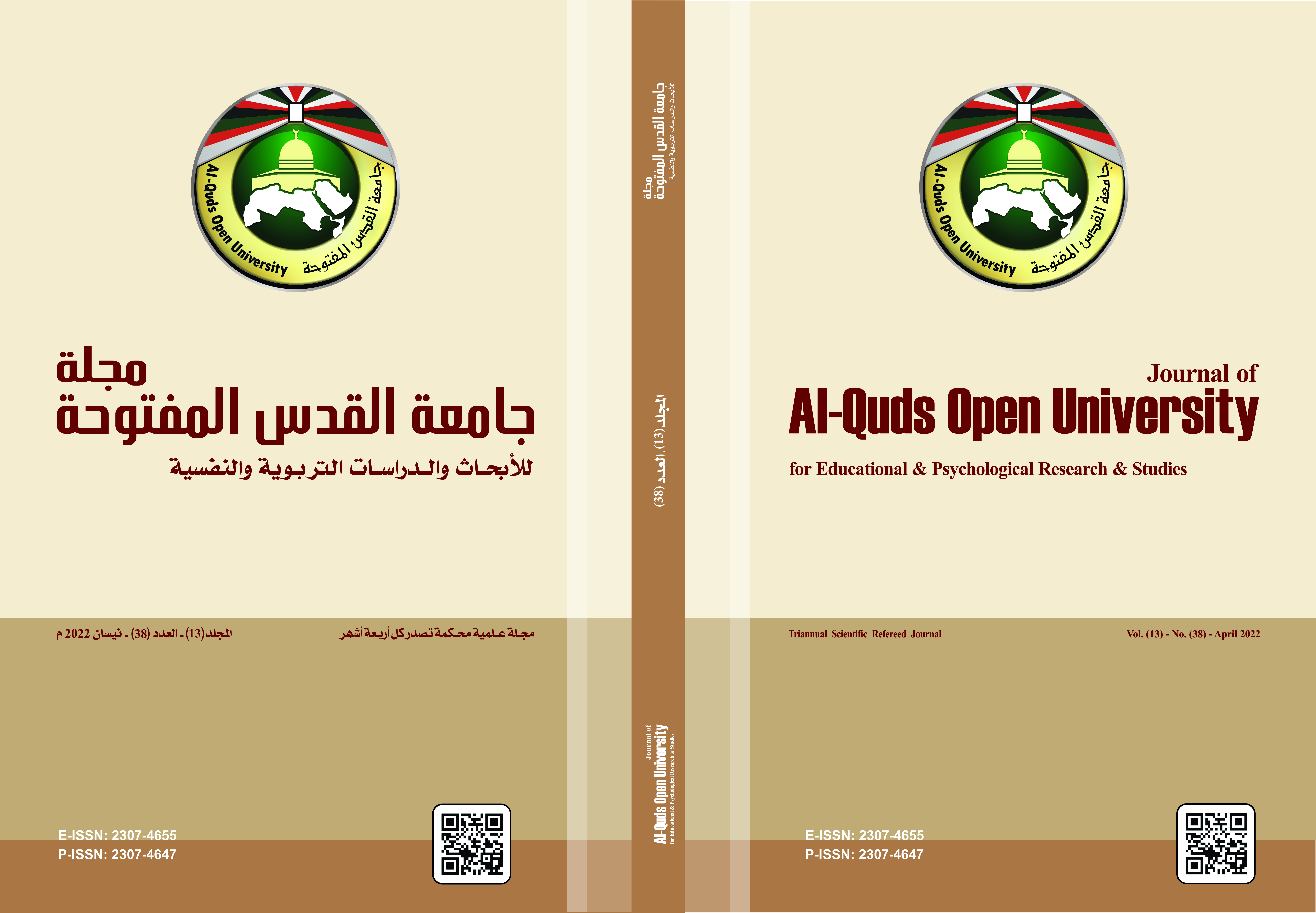The Practice of Secondary School Principals on Impression Management and Its Relationship to Teachers’ Organizational Identity at the Hebron Southern Directorate of Education
DOI:
https://doi.org/10.33977/1182-013-038-002Keywords:
Impression management, organizational identity, Directorate of Education/South HebronAbstract
This study aimed to identify the degree of public secondary school principals’ practice of impression management and its relationship to the teachers’ organizational identity. It also aimed at testing the effect of each of the variables of gender, academic qualification, and years of experience on the degree of the practice of impression management and the level of organizational identity among teachers. The population of the study consisted of all secondary school teachers with a total of 722 in the Hebron Directorate of Education. The study was conducted on a stratified random sample of 361 teachers, forming 50% of the population of the study. The researcher Developed the impression management questionnaire and the organizational identity questionnaire. The study showed the following results: The degree of practicing impression management and the level of the organizational identity both came with high degrees with a positive statistically significant correlation between the practice of impression management and the level of organizational identity. Results also showed no statistically significant differences in the estimates of the subjects of the sample for the degree of impression management practice and the level of organizational identity attributed to the variables of gender, qualification, and years of experience.
References
المراجع
عبد الفتاح، محمد وأبو يوسف، محمود. (2016). دور القيادة الخادمة في تحقيق التماثل مع الهوية التنظيمية بمدارس التعليم قبل الجامعي بمصر من وجهة نظر المعلميـن»، مجلة العلوم التربوية، ج. 1، ع. 2، أبريل، ص: 310-204.
عبد اللطيف، عبد اللطيف وجود، محفوظ. (2010). دور الثقافة التنظيمية في التنبؤ بقوة الهوية التنظيمية: دراسة ميدانية على أعضاء هيئة التدريس في الجامعات الأردنية الخاصة، مجلة جامعة دمشق للعلوم الاقتصادية والقانونية، العدد(2)، المجلد (26)، ص: 119_156.
حريم، حسين. (2004). السلوك التنظيمي سلوك الأفراد والجماعات في منظمات الأعمال، دار الحامد للنشر والتوزيع، عمان، الأردن.
رشيد، مازن. (2003). الهوية التنظيمية والتماثل التنظيمي: تحليل للمفهوم والأبعاد السلوكية لتطبيقاته، مركز بحوث كلية العلوم الإدارية، جامعة الملك سعود: الرياض.
عبد الستار، ماجدة. (2014). القوة التنظيمية وعلاقتها بالهوية التنظيمية لدى مدراء المدارس الإعدادية في مديرية الكرخ الأولى، مجلة كلية التربية الرياضية، جامعة بغداد، المجلد السادس، العدد الأول، ص: 103_113.
البريدي، عبد الله. (2007). الهوية التنظيمية كيف ينظر الأفراد إلى منظماتهم، مجلة التدريب والتقنية، العدد (96)، المؤسسة العالمية للتدريب التقني، الرياض.
بكر، سوزان. (2018). دراسة الاتجاهات نحو أساليب إدارة الانطباع وأثرها على الهوية التنظيمية بين العاملين الإداريين في جامعة الأزهر، المجلة العربية للإدارة، مجلد (38)، عدد (2)، 167_ 190.
منهل، محمد. (2016). تأثير استراتيجيات إدارة الانطباع في اضطرب ما بعد الصدمة: الدراماتوج متغيراً تفاعلياً دراسة ميدانية في شركة الحفر العراقية، مجلة العلوم الاقتصادية والإدارية، العدد (9) المجلد (22)، ص 240_ 265.
Gwal, Rajeshwari. (2015) Tactics of Impression Management: Relative Success on Workplace .44- 37. Pp. 2 Issue, 2. Vol, Psychology Indian of The Journal International of Indian Psychology, Vol. 2, 2 Issue, Pp.37-44.
Jarne,sarah (2014). Organizational Identity in Practice_ How Theoretical Concepts of Organizational Identity are Perceived in the Empirical Setting of Arla Foods”, Master Thesis, Department of Business, Studies, Uppsala University.
Yilmaz, Ozgur D.(2014).Perception of Organizational Politics and Impression Management Behaviors: A Tourism Industry Perspective. International Journal of Business and Social Science Vol. 5, No. 8,pp,. 98-109.
Albert، Stuart and David A. Whetten (2006), " Organizational Identity"In. Organizational Identity, Edited by Mary Jo Hatch and Majken Shultz, Oxford University Press.
Terrell ,K.,& Kwok, L,.(2012). Organizational Impression Management Behaviors in Social Media: A Perspective of a Social Networking Site, Journal of Organizational Behaviour, P85- 93.
Inancevech, J.M. and Matteson , M.T.( 2002).Organizational behavior and management, 6th .Ed. , McGraw –Hill/Irwin .
Barash, V., Ducheneaut, N., Isaacs, E & Bellotti, V., (2010), “Faceplate: Impression (Mis) management in Face book Status Updates”, Proceedings of the Fourth International AAAI Conference on Weblogs and Social Media, 207- 210.
Erdogan. Irmak, Development of a Scale to Measure Impression Management in Job Interviews, World Journal of Social Sciences, Vol. 1. No. 5. November 2011. Pp.82-97.
lussier , R.N.(2005),Human relations in organizations :Applications and skill building ,sixth Ed. McGraw –Hill/Irwin , U.S.A.
Guadagno. Rosanna & Robert B. Cialdini. (2007). Gender Differences in Impression Management in Organizations: A Qualitative Review, Springer Science, 10, p1-12.
Westphal, J. D.(2010). Commentary An impression management perspective on job design: The case of corporate directors, Journal of Organizational Behavior, 31, p319– 327.
Alvesson, Mats and Emposn, Laura. (2008). The construction of organizational identity: Comparative case studies of consulting firms, Scandinavian, Journal of Management, 24(1), 1-16.
Necef, M., (2002), “Impression Management and Political Entrepreneurship in Denma” Paper prepared for the ECPR Joint Session Turin, Italy, Workshop No.14 , 22-27.
Iddekinge, C., McFarland, L& Raymark, P., (2007), “Antecedents of impression management use and effectiveness in a structured interview”, Journal of Management, Vol.33, No.5, 752-773.
Drory, A., & Zaidman N,.(2007). Impression management behavior: effects of the organizational system. Journal of Managerial Psychology, 22, 290308.
Guadagno. Rosanna & Robert B. Cialdini, Gender.(2007). Differences in Impression Management in Organizations: A Qualitative Review, Springer Science, 10, p1-12.
Downloads
Published
How to Cite
Issue
Section
License
- The editorial board confirms its commitment to the intellectual property rights
- Researchers also have to commit to the intellectual property rights.
- The research copyrights and publication are owned by the Journal once the researcher is notified about the approval of the paper. The scientific materials published or approved for publishing in the Journal should not be republished unless a written acknowledgment is obtained by the Deanship of Scientific Research.
- Research papers should not be published or republished unless a written acknowledgement is obtained from the Deanship of Scientific Research.
- The researcher has the right to accredit the research to himself, and to place his name on all the copies, editions and volumes published.
- The author has the right to request the accreditation of the published papers to himself.







2.png)






_2.png)

